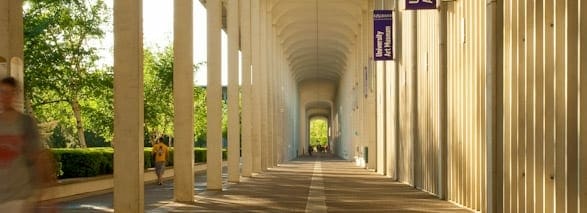ALBANY — The University Art Museum presents Sara Magenheimer: Dailies, a commissioned solo exhibition of video, vinyl text, and sculpture by artist, filmmaker, and poet Sara Magenheimer. Concurrently in our Collections Study Gallery, the UAM presents Chryssa’s screenprint series Gates to Times Square, which refigures letterforms and characters of neon signs.
Sara Magenheimer: Dailies
“This time of social upheaval has re-invigorated language as it performs publicly, in posters and protest signs, tweets, captions, chyrons and political speeches,” writes artist, poet, and filmmaker Sara Magenheimer. Magenheimer sublimates her own poetic language into the work in her commissioned solo exhibition Dailies. Turbulent distortions of vinyl texts spanning the museum walls, still and animated text in her video works, and intimately scaled wire and found object sculptures embody the major themes of the exhibition: rest, absence, motion, stillness. Ever sensitive to architecture and the body, Magenheimer has created a contemplative environment inviting viewers to move with and through language and subtly reflect on power, politics, and poetics.
The words inhabiting the museum both in vinyl and in video often draw from Magenheimer’s Beige Pursuit (2019, Wendy’s Subway), the artist’s book of poetry now in its second edition. Additional video works include a projection of a 24-hour video clock that keeps time with the slow, often indiscernible movement of 24 flower species that each naturally bloom at a specific hour of the day, as well as a screening room hosting earlier video pieces that chart the arc of Magenheimer’s thought over the last decade.
Time and ephemerality recur in wire and found object sculptures imbued with memory for Magenheimer, and inverted black-and-white headshots of actresses alongside their redacted resumes reflecting on the “shelf-life” of actresses.
Throughout the exhibition, Magenheimer explores the conventions of the printed page while offering an expanded mode of reading that can happen in the context of an art space and the world at large.
Chryssa: Gates to Times Square
Taking language from the world, specifically the letterforms and characters from neon lights in Manhattan in the 1960s and 1970s, Chryssa refigures them in her series of screenprints Gates to Times Square (1978) on view in the University Art Museum’s Collections Study Gallery. These 16 large-scale prints from the University at Albany Fine Art Collections represent an important moment in Chryssa’s life-long investigation of text as image.
Emerging from the Coenties Slip group in lower Manhattan in the 1950-1960s, alongside Agnes Martin and Ellsworth Kelly, Chryssa drew inspiration from her immediate urban environment, as well as ancient Cycladic sculpture from her native Greece, and became a forerunner in the use of neon in the fine arts.
The Gates to Times Square prints show how Chryssa continued to think through the visual and textual ideas of her monumental and immersive neon, Plexiglas, and steel sculpture The Gates to Times Square (1964-1966). Chryssa’s interest in written text began even earlier, notably in her baked-clay tablets Cycladic Books (1957) and found new form in her 1970s-1980s study of Chinatown shop signs produced concurrently with the prints on view.
One finds in Gates to Times Square tangled patterns of saturated red and blue, nested lines in unexpectedly meditative formations, and stillness in her monochrome gray hard-edge geometric forms. Recurring patterns and structures appear as Chryssa reuses a core set of silkscreens to explore variable relationships between figure and ground, challenging the ways we read the image.
Sara Magenheimer is an artist whose work spans filmmaking, video installation, writing, and sculpture. She is based in New York. Recent solo exhibitions include the New Museum, NY; Portland Institute for Contemporary Art (PICA), or; The Kitchen, NY.
Chryssa (Chryssa Vardea-Mavromichali, b. Greece, 1933-2013) is known for her sculpture and assemblage and was one of the first to use neon as a fine art medium beginning in 1962.
She had studied in Paris and San Francisco and moved to New York in 1954, and also established a studio in Athens in 1992.
Her work is in numerous collections including Museum of Modern Art, the Guggenheim Museum, the Whitney Museum of American Art in New York, and the Corcoran Gallery of Art in Washington.



